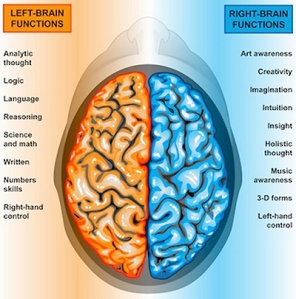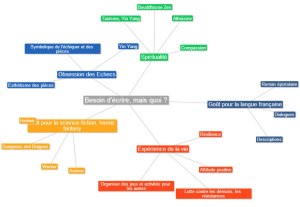Being human is mostly about work, but also about creativity.
Or the other way around, because you have to be creative to get some news ideas in order to invent new concepts or pieces of art. Then you can work on them. And be creative again, initiating and maintaining a virtuous circle of “added value”…
As I first learned in the books of Bernard Werber, my favorite writer, those main tasks are mastered by our two brain hemispheres, as it is described in the small image below:
Our education is mainly about “linear or sequential thinking”: idea 2 comes after idea 1 and precedes idea 3, and so on. In France, the country where “form” is more important than “content”, most of the writings or homework you have to perform during school, high school and university must obey to strict rules. And thus it is not easy to communicate all you want to say: you sometimes have to break the rules…
Anyway, when you hear or read a story, there usually is a beginning, a development, and an ending. That’s it. So it is for writing, what I am doing write now, trying to establish a kind of telepathy with you, the reader.
But our brain does not “think” like that. Very seldom in fact. We can perform this sequential thinking because we are trained to conceptualize like that and because it is the safest way to express our ideas and increase the chances of being understood by others, so far as we are a social species.
Our brain can perform its thinking on multiple layers, but our mouth or hands can express this thinking on a very restrictive mode (our gestures or “non-verbal language” are in fact our best way to communicate): we can compare that to connections in parallel versus connections in series. In the first electrical model you can inject more information than in the second.
Our brain likes to make connections, to jump from one idea to the other, to create associations that sometimes would appear weird or completely “illogical”. And sometimes we feel stuck whithin a creativity process: we have ideas, too many ideas, and cannot find a satisfactory way to transform this “parallel or complex” thinking into “series” thinking.
Well, one man called Tony Buzan created a very powerful tool named the “mind map“: first you draw a “bubble” on the center of a piece of paper. This first bubble will contain your idea or the concept you try to develop (as far as we are concerned, we use it to create e-books or business plans). Then you draw other bubbles connected to the first, following your thinking, and trying to remain “free” of concepts, so you can get rid of your “normal” and “usual” concept thinking.
After “bubbling” a while on your mind map, you will clearly SEE that a structure is appearing to you, to your conscious mind (the left brain). This structure is in fact the work of your right brain, the subconscious mind. The “mind map” is a small window on what your subconscious mind is actually doing, and in this matter is an accurate tool of introspection… Pretty amazing! And then, having this “map” under your eyes, your rational (or conscious mind) can take the work over and process it into an “acceptable” and “real” form.
Here is an example of “mind map”, made on the excellent webapp “Text 2 Mind Map“:
I experienced this “mind mapping revelation” several times and I am definitively a big fan and promoter! I even introduced my 12-years-old boy on mind-mapping and he really likes it!
So, to be concrete and somewhat helpful to you, I tried several free mind mapping softwares, and the best I found is “Freeplane”. Slightly better than “Freemind” as it as more features and you can export in many formats. You can download “Freeplane” following this link.
Well, that is all for now and I will come back with other explanations on this great piece of free software!
Until then, take care.





have you tried scapple ?
LikeLike
No, I have not. I prefer to use some open resources…
Do you have a good experience with “Scapple” ?
LikeLike
One of the best I’ve ever had so far. I intend to write a post about it for my Camp NaNoWrimo planning in a few days. I’ll showcase one of my “scapples” then. It’s a very powerful tool which is a real delight to work with. The silver lining : scapple files can be integrated in Scrivener.
LikeLike
Hello again Duchesse !
I did some digging and just found a free alternative to “Scapple” concept mapping software. It is called VUE and can be downloaded just here : http://vue.tufts.edu/index.cfm
I’ll give a try some day and post some feedback !
Cheers !!
Anyway, I can’t wait to see your own “scapples” and learn something new !
Have a sparkling day !
LikeLike